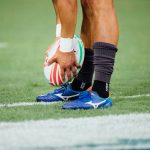With the calendar officially flipping to January and Spring Training about a month-and-a-half away, everyone around baseball is focusing squarely on the 2019 season. That doesn’t mean certain players aren’t still using their 2018 performance as motivation, though.
Whether last year was a strong one or a disappointing one on an individual basis, there are plenty of starting pitchers with a lot to prove once April rolls around. The following six hurlers are each at different stages of their respective careers, but they all have one thing in common — they should be taking the mound with a chip on their shoulder this year. Knowing which pitchers are poised to do well is an important piece of information for sports bettors. Fans looking to wager on baseball in 2019 can take advantage of the William Hill Promo Code when making their bets. If you’re looking to gamble on baseball, the six pitchers below are players to keep an eye on.

Aug 29, 2018; Kansas City, MO, USA; Kansas City Royals starting pitcher Danny Duffy (41) delivers a pitch in the first inning against the Detroit Tigers at Kauffman Stadium. Mandatory Credit: Denny Medley-USA TODAY Sports
Danny Duffy, Kansas City Royals
Despite compiling 6.2 fWAR through his most recent 326 innings of work heading into 2018, Danny Duffy went from being a potential trade candidate for a rebuilding Royals club to a hurler in need of a bounce back campaign.
The southpaw tossed 155 frames this past year, yielding a disappointing 4.88 ERA, 1.49 WHIP, 20.4% strikeout rate, 10.1% walk rate, and 1.1 fWAR.
In fact, after setting new single-season career-best marks in strikeout rate (25.7%) and walk rate (5.8%) in 2016, both of those numbers have gotten worse in each following season. Duffy also allowed 1.34 homers per nine innings, which is a stark difference to the 0.80 mark he posted in 2017. He’s always been more of a fly-ball pitcher (42.6% rate in ’18), but it didn’t help that he allowed hard contact at a 37.9% clip — a career worst.
It’s also worth noting that the lefty’s slider usage cratered compared to recent years. After throwing it at least 23.0% of the time between 2015 and 2017 (including at a career-high 29.4% rate in ’17), that number dropped to 16.3%. Opposing hitters posted a .913 OPS, .278 ISO, and 157 wRC+ against it in 2018. Those numbers were .595, .075, and 70, respectively, the prior year.

Sep 15, 2018; St. Louis, MO, USA; St. Louis Cardinals relief pitcher Luke Weaver (7) reacts after giving up a three run home run to Los Angeles Dodgers right fielder Yasiel Puig (not pictured) during the eighth inning at Busch Stadium. Mandatory Credit: Jeff Curry-USA TODAY Sports
Luke Weaver, Arizona Diamondbacks
Things can change quick in baseball — just ask Luke Weaver. Following 60.1 dominant innings in 2017, he was viewed as a crucial piece of the Cardinals’ future rotation. A year later, he’s now on the Arizona Diamondbacks after being part of the Paul Goldschmidt trade.
Following a 3.88 ERA and 1.4 fWAR with a 28.6% strikeout rate and 6.8% walk rate during that solid ’17 campaign, those numbers worsened to 4.95, 1.3, 19.9%, and 8.9%, respectively, through 136.1 innings. He also started bouncing between the rotation and bullpen a bit in the second half, which didn’t go well (10.29 ERA in seven innings as a reliever).
The goal should be to get his fastball back on track, which should positively impact the rest of his arsenal. Here’s how his walk rate and strikeout rate compare between 2017 and 2018 for his three most-used pitches:


Sep 8, 2018; Seattle, WA, USA; Seattle Mariners starting pitcher Felix Hernandez (34) throws against the New York Yankees during the fourth inning at Safeco Field. Mandatory Credit: Joe Nicholson-USA TODAY Sports
Felix Hernandez, Seattle Mariners
King Felix has routinely been one of baseball’s best pitchers since debuting in 2005, but he hasn’t been the same for a while now. Hernandez has thrown more than 2,600 innings as a big-leaguer and tossed at least 190 frames each year between 2006 and 2015. The wear and tear has clearly taken its toll on the 32-year-old — he’s failed to crack 160 innings in a single season since 2016, and his velocity continues to plummet.
As a rookie, Hernandez boasted an average fastball velocity of 95.8 miles per hour. In 2018, that number settled in at just 89.3, part of a mostly steady nosedive since 2010. His 18.3% strikeout rate was not only a single-season career low, but it’s also the second time in three years he’s failed to crack 20.0%.
He’s simply not the pitcher he used to be anymore, and it’s taking time to figure out how he can be successful without his old fastball. The right-hander and former AL Cy Young Award winner is trying to find some answers — his 42.8% fastball usage rate was the lowest it’s ever been, while he leaned heavily on his curveball (27.9% usage rate) and changeup (24.2% usage rate).
Those were his two most successful pitches when it comes to results, as opposing hitters mustered just a 78 and 87 wRC+, respectively, against them. Hopefully he’s on the verge of figuring it all out as he enters the last guaranteed year of his contract with the Mariners.

Sep 22, 2018; Miami, FL, USA; Cincinnati Reds starting pitcher Anthony DeSclafani (28) delivers a pitch in the first inning against the Miami Marlins at Marlins Park. Mandatory Credit: Steve Mitchell-USA TODAY Sports
Anthony DeSclafani, Cincinnati Reds
The Cincinnati Reds haven’t had a good starting rotation for a number of years, and they’ve been actively trying to fix. General manager Dick Williams has already acquired Tanner Roark and Alex Wood to serve as building blocks for 2019, and he’d probably like DeSclafani to join the party, too.
He was one of the few bright spots for the Reds’ starting staff in 2015 and 2016 (5.1 combined fWAR). Unfortunately, he proceeded to miss all of 2017 and part of 2018 due to elbow and oblique injuries. He produced a disappointing 4.93 ERA and 0.6 fWAR in 115 innings upon finally getting back on the hill.
Although he did allow hard contact at an alarming 41.9% rate, there were some positive signs. His 22.3% strikeout rate was actually a career high, while his 6.2% walk rate fell within his career norms. Overall, a 3.96 SIERA is at least encouraging as he continues to get himself back to normal.

Aug 17, 2018; Bronx, NY, USA; Toronto Blue Jays starting pitcher Marcus Stroman (6) pitches against the New York Yankees during the first inning at Yankee Stadium. Mandatory Credit: Andy Marlin-USA TODAY Sports
Marcus Stroman, Toronto Blue Jays
Following consecutive seasons of 200-plus innings and at least 3.0 fWAR, Marcus Stroman’s 2018 season was a real bummer. Right shoulder fatigue, a finger blister, and just overall poor performance led to him accruing just 102.1 innings and being worth 1.5 fWAR.
That hasn’t stopped his name from popping up in trade rumors this winter, but it’s mostly as a buy-low candidate, which the Blue Jays should be trying to avoid.
The right-hander allowed his highest BABIP (.326) for a single season, along with a career-worst strand rate (60.5%) and an elevated walk rate (8.0%). Clearly, that’s not a recipe for success, but it’s good to see that there wasn’t a huge change in his batted-ball profile. In fact, this was the third straight year in which he threw at least 100 innings and posted a ground-ball rate higher than 60.0%.

Sep 24, 2018; Denver, CO, USA; Colorado Rockies starting pitcher Jon Gray (55) leaves the infield following the top of the seventh inning against the Philadelphia Phillies at Coors Field. Mandatory Credit: Ron Chenoy-USA TODAY Sports
Jon Gray, Colorado Rockies
The 2018 season was a weird one for Jon Gray. He entered it as the ace of the Colorado Rockies’ staff but was pitching in Triple-A by the end of June after posting a 5.77 ERA through his first 17 starts.
He only spent two starts down in the minors before getting recalled to the big leagues. Despite the struggles and demotion, the right-hander still managed to set a new career-high in wins (12) and innings pitched (172.1).
Gray’s batted-ball profile didn’t change much when compared to 2017, but his quality-of-contact numbers sure did. After posting career bests in soft-hit rate (22.7%) and hard-hit rate (28.4%) in ’17, those numbers worsened to 16.0% and 36.1%, respectively. That likely also contributed to his career-worst 1.41 homers allowed per nine innings. Prior to 2018, that number had never been higher than 0.96.
Gray has continued increasing the usage of his slider and curveball, and while they were still his most effective pitches this past year, they weren’t nearly as productive as the year before. His slider produced a 31.8% strikeout rate and 80 wRC+ in ’18 (38.6% and 28 in ’17), and his curveball produced a 41.6% strikeout rate and 57 wRC+ (40.0% and 20 in ’17).







